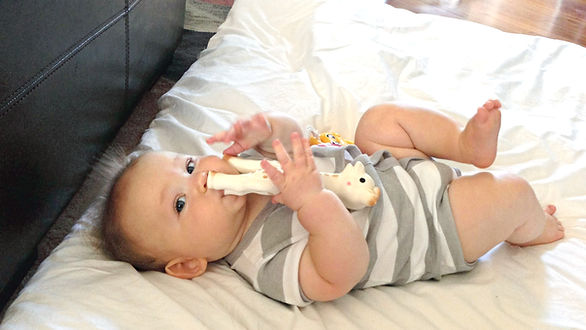If you’ve got a little one going through the teething stage, you know it’s tough. The constant drooling, the crying, and the need to chew on everything in sight—it’s a challenging time for both baby and mom. Teething bracelets can be a real lifesaver during this stage.

This site contains affiliate links; please view the disclosure for more information.
What are Teething Bracelets?
Teething bracelets are wearable teething toys designed for babies. There are two varieties: ones made specifically for babies to wear and ones worn by caregivers for babies to chew on. Designers create these baby-worn bracelets to be safe and accessible for little ones to chew on, soothing their teething discomfort. They’re available in various designs, colors, and textures, serving both as a relief tool for teething symptoms and a sensory toy.
How to Use Teething Bracelets
For Caregiver-Worn Bracelets:
- Wear on Wrist: The caregiver wears the bracelet on their wrist.
- Supervised Chewing: Allow the baby to chew on it under supervision.
- Regular Cleaning: Keep it clean, as babies will frequently put it in their mouths.
For Baby-Worn Bracelets:
- Fit on Baby’s Wrist: Place the bracelet on your baby’s wrist or ankle.
- Close Supervision: Always keep an eye on your baby while they’re wearing it.
- Frequent Checks: Regularly check for any signs of damage or wear.

Appropriate Age for Teething Bracelets
Teething bracelets are suitable for babies from around 3–4 months old, the typical starting age for teething, up to about 2–3 years old. For baby-worn bracelets, ensure they fit snugly but comfortably, without posing a risk of getting too tight or causing discomfort.
Materials Used in Teething Bracelets
Common Materials:
- Silicone: Food-grade silicone is safe, soft, and chewable.
- Natural Wood: A harder alternative, often preferred by some babies. Ensure it’s smooth and untreated.
- Fabric: Less common, used in combination with other materials.
Safety Considerations:
- Non-toxic: The materials should be free from harmful chemicals.
- Age-appropriate Size: Ensure the bracelet fits properly on a baby’s wrist or ankle.
- Durability: It should be able to withstand regular chewing and pulling.
Understanding Amber Teething Bracelets
Amber teething bracelets are a unique type of teething aid, highly sought after by many parents for their natural appeal and purported health benefits. Unlike other teething bracelets made from silicone or wood, amber teething bracelets are crafted from Baltic amber, a fossilized tree resin. Many people believe that a baby’s skin warms amber, releasing succinic acid, which eases pain and helps with teething.
Key Points on Amber Teething Bracelets:
- Composition: Made from Baltic amber, known for containing succinic acid.
- Usage: Worn by babies, they are often chewed on, although there is a debate about their safety in this regard.
- How it works: Chemicals that ease pain are thought to be released when heated by the skin.
- Aesthetic Value: They come in many natural colors and are often liked for how beautiful they are.
Safety Considerations
While there’s a large market for amber teething bracelets, safety considerations are paramount, especially since these bracelets are often put in babies’ mouths.
- Choking Hazard: The primary concern is the risk of beads coming loose, which could pose a choking hazard. Regular inspection of the bracelet for any loose beads or weakened string is crucial.
- Authenticity: Ensuring that the amber is genuine is important, as fake amber won’t have the same properties and could be made of harmful materials.
- Supervision: Always supervise your baby when they are wearing an amber bracelet. It’s advisable not to leave the bracelet on while the baby is sleeping or unattended.
- Size and Fit: The bracelet should fit comfortably, not too tight or too loose. A snug fit ensures the baby can’t easily take it off and put it in their mouth, which reduces the risk of swallowing any beads.
The Debate Around Usage
There is some debate about whether babies should chew on amber bracelets. People who support it say that it relieves pain naturally, while people who are against it say that it is unsafe, especially because of the risk of choking. It’s essential to weigh these considerations and make an informed decision as a parent. Some opt to use amber bracelets solely as a wearable item, not for chewing, to mitigate the risk while still benefiting from the alleged pain-relieving properties of the amber.
Amber teething bracelets continue to be a popular choice among parents for their natural and aesthetic qualities. However, it’s important to prioritize safety by ensuring the integrity of the bracelet, supervising its use, and being aware of the ongoing debate regarding its safety for oral use. As with any teething aid, you should use your best judgment and keep a close eye on your baby to make sure they are safe.
Safety Concerns
- Choking Hazard Prevention: Ensure there are no small parts that could break off.
- Regular Inspection: Check for signs of damage or potential hazards.
- Proper Fit: For baby-worn bracelets, ensure they fit well and aren’t too tight or loose.
- Hygiene: Regularly clean the bracelet to maintain hygiene.
- Supervised Use: Never leave your baby unattended with a teething bracelet.

Benefits of Teething Bracelets for Babies
Soothing Teething Relief: Teething bracelets offer babies a convenient and accessible teething surface to chew on whenever they need relief. The gentle pressure and texture can help alleviate discomfort and provide a comforting sensation to their gums.
Sensory Stimulation: Teething bracelets often feature different colors, shapes, and textures, providing sensory stimulation for your baby. This stimulation promotes their cognitive and motor skill development as they explore the various elements of the bracelet.
Fine Motor Skill Development: As your baby grasps and manipulates the teething bracelet, they strengthen their fine motor skills. The act of holding, chewing, and exploring the bracelet helps enhance their hand-eye coordination and dexterity.
Distraction and Fun: Babies can have a hard time when they are teething, so giving them a teething bracelet to chew on can help. It can help redirect their attention and provide a source of entertainment during uncomfortable teething episodes.
Teething bracelets can be a great aid during your baby’s teething phase. They offer a chewable solution that’s right at hand (or on the wrist!) for babies, helping to soothe sore gums. No matter who wears these bracelets—the baby or the caretaker—they should always be used with safety and cleanliness in mind. With the right bracelet, teething can be a more bearable experience for both you and your little one.



